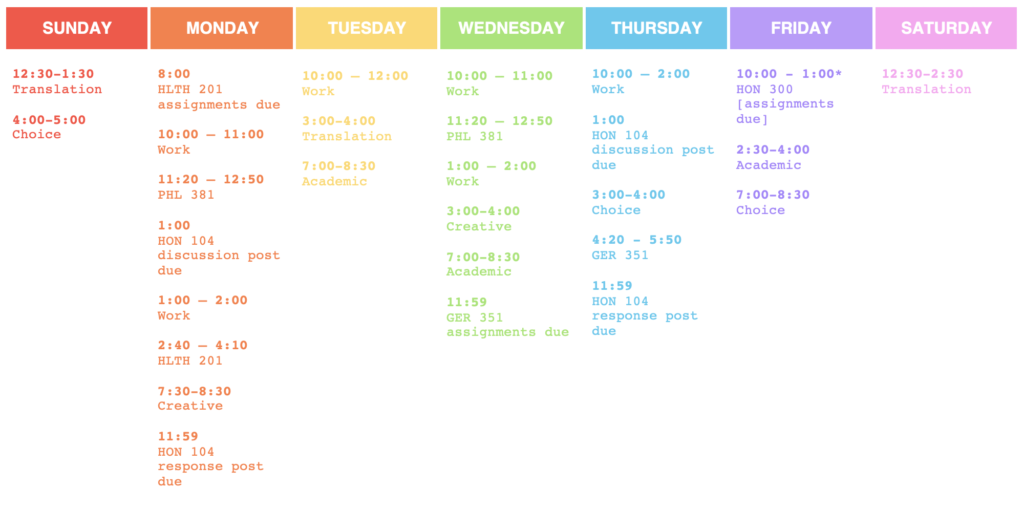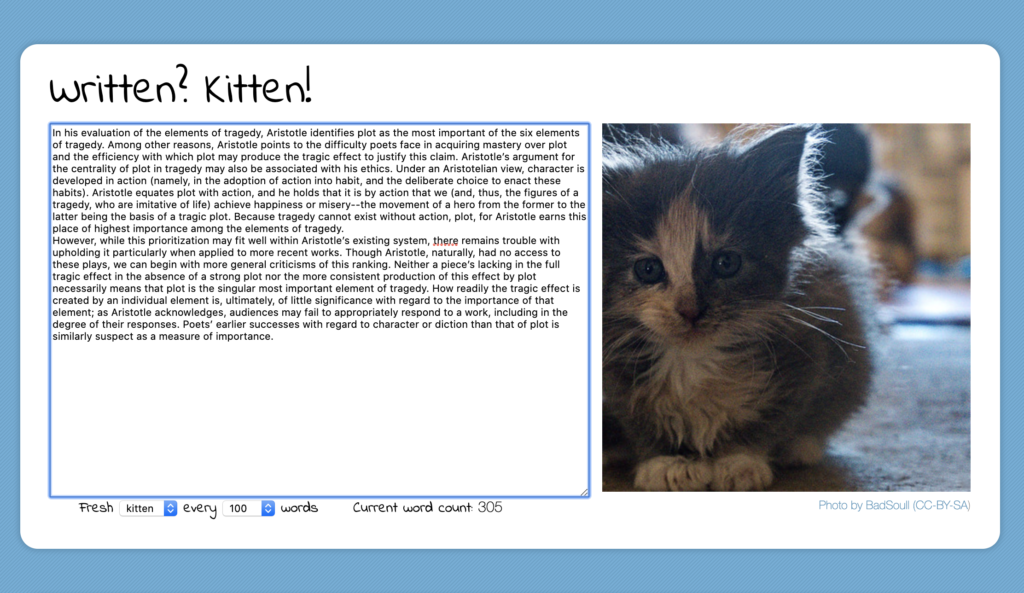Summers without courses seem to lose their structure entirely for me, and, when I heard the news of classes going online this spring, I immediately began anticipating that same haze setting in. With the added necessity of staying home keeping me from using one of my favorite ways of breaking up my day, a change of scenery, I was feeling especially nervous about working on my personal and academic projects this quarter. To address these concerns, I’ve spent the past few weeks trying out different strategies to bring a little bit of order back into my schedule—especially when it comes to making time for writing. In this post, you’ll find four of the strategies I’ve found most helpful in continuing to write in quarantine.
Pomodoro Technique
What I did: The Pomodoro technique involves taking a five-minute break for every 25 minutes of work, with a longer break between 15 and 30 minutes every four rounds (every two hours). Often used for studying, the Pomodoro technique is used to help minimize the impact of interruptions on your work.
Why I like it: It’s approachable! Just like staring at a blank page can be intimidating, looking toward several uninterrupted hours of writing when you’re just trying to get through the day can be a struggle. By breaking the time up into smaller bits, I find it easier to keep focus and get started. What’s more, reading over your progress after a round can be a satisfying way to step back and appreciate the work you’ve put in so far. The breaks are also a good reminder to take care of yourself—grab some water or a snack, listen to a favorite song, or whatever suits you as long as you’re back to writing when the five minutes are up.
What might not work: If interruptions are more distracting than relaxing, the constant breaks might keep you from feeling totally involved in your work.
Modify it: Try different round lengths if the 25-minute ones aren’t working for you. Maybe you want to work for 50 minutes and break for 10, or work for 10 and break for three. If you have other markers of time, like classes or mealtimes, you might try using those instead of traditional round. The idea is just to be working in intervals; as long as you’re doing that, you’re keeping to the spirit of the Pomodoro technique.
Fixed Schedule

What I did: Used Microsoft Word to draw up a simple table for the week, then wrote out a timed list of my inflexible commitments (e.g., shifts at the writing center, class times), including writing time among them. While doing this, I also tried to take into account my flexible commitments—daily walks, mealtimes, etc.—to keep myself from burning out by over scheduling myself.
Why I like it: Having moved back with family for quarantine, this helped give my family a better idea of when I was available and when I was working. It also gave me a consistent commitment every day, which was especially helpful for working on some of my longer-term projects. If you (or maybe someone you live with
What might not work: Things come up in life, and that’s especially true now. If you rely on a schedule like this to keep you committed, you may feel derailed by missing a day (or several) and have trouble starting back up. If, like me, you commit yourself to a specific project or genre at a particular time, it may also be difficult to balance your personal projects with class assignments.
Modify it: Give yourself free days! Whether a few days a week or a few days a year, take the time you’d normally be using to write to do something for yourself, then come back refreshed when your schedule resumes.
Accountability Group
What I did: Set up a small group dedicated to holding each other responsible for writing-related goals. We chose to set up dates to share our work over Zoom, with the expectation that each person bring an update for the session, but you can set different conditions with your friends based on your personal goals. For a more low-key commitment, send a text asking your friend to nag you about your word count. For higher stakes, take a page from Alice Wu’s book, who asked her friend to send a check to the NRA if she didn’t finish her first draft of The Half of It within five weeks.
Why I like it: It mixes writing time and social time! With the situation with coronavirus as it is, we’re all seeing less of the people we care about, and this method is one way of connecting with friends across the distance. Exchanging work can also be a motivating element—your friends are brilliant, and they definitely have a million good ideas to inspire you.
What might not work: The sharing-updates format can feel a little high stakes, especially if you’re someone who likes to refine their work a little more before sharing it with the world. It also asks a little bit from other people, so you’ll need some kind of support to try out this particular method.
Modify it: Use the UCWbL—attend Writers Guild or make a repeating appointment with a tutor you mesh with. If you’re working on an academic piece, consider asking a favorite faculty member if they’re willing to give you feedback (and be understanding if they’re not able).
Reward System

What I did: Cat-lover that I am, I used Written? Kitten!, which shows an image of an adorable cat pulled from Flickr for every 100, 200, 500, or 1000 words you write. For those less faint of heart than yours truly, you can also use a system like Write or Die, which offers both reward and consequences based on your settings. If you’re not terribly technologically inclined, you can achieve a similar effect with snacks every time you reach a certain milestone.
Why I like it: Word-count-based systems can help curb perfectionism in first drafts. I’m someone inclined to think for ages about a single word (especially in major papers!), so using reward systems helps me to get the ideas out without worrying quite as much about how they sound.
What might not work: If you’re trying to polish an existing draft, automated systems that prioritize number of words written won’t necessarily help. If you’re inclined toward distraction, they might also keep you from focusing on your project.
Modify it: If you’re working on revisions, use the basic model to design your own system. For every 500 words you revise, consider treating yourself to a candy or favorite song. If you need to cut down on words, consider using the system in reverse—reward yourself for every 100 words you’re able to remove from your draft.
Let’s Get Started!
This list is by no means comprehensive, but it does represent some of my favorite ways of dealing with the absence of structure, motivation, or both—whether that’s brought on by the changes we’re dealing with now or more mundane causes.
So, what strategies have you been using lately? Have you had to modify your standbys to deal with these strange circumstances?
